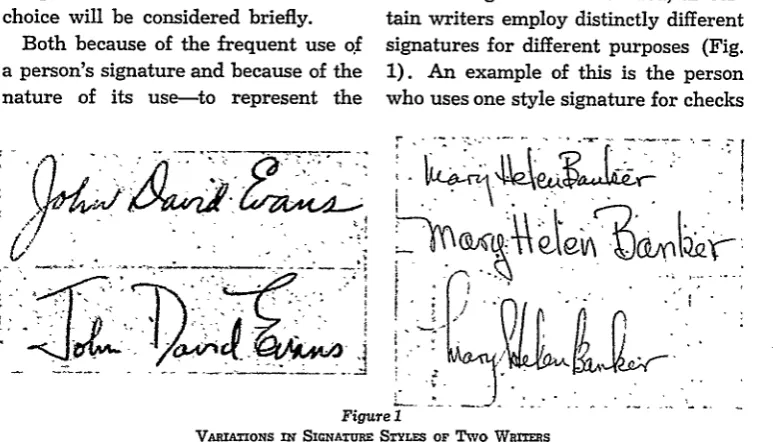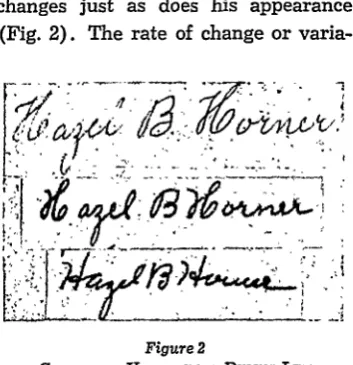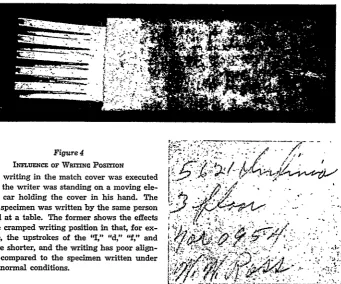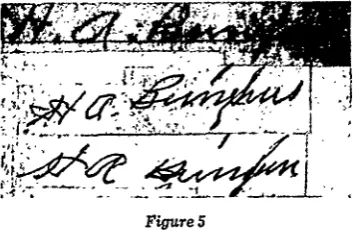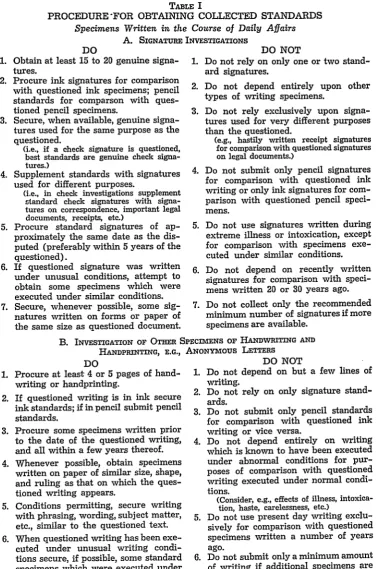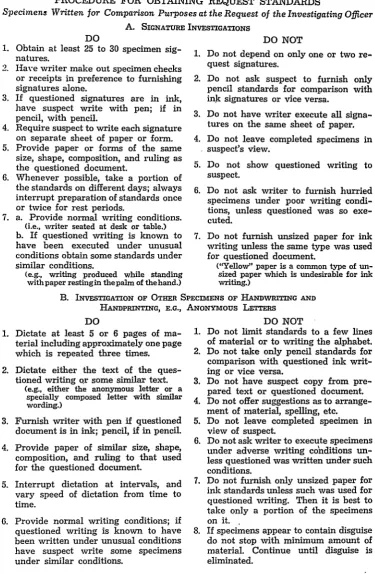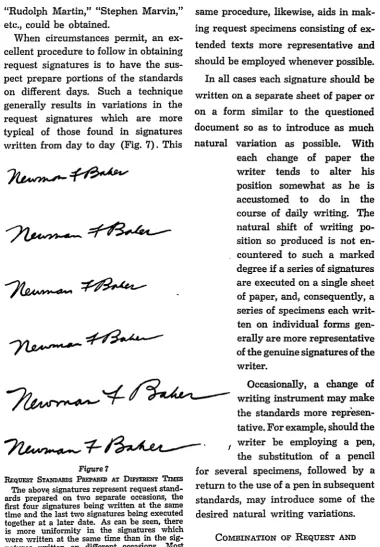Journal of Criminal Law and Criminology
Volume 32 | Issue 2
Article 13
1941
Collection of Writing Standards in Criminal
Investigation, The
Ordway Hilton
Follow this and additional works at:
https://scholarlycommons.law.northwestern.edu/jclc
Part of the
Criminal Law Commons
,
Criminology Commons
, and the
Criminology and Criminal
Justice Commons
This Criminology is brought to you for free and open access by Northwestern University School of Law Scholarly Commons. It has been accepted for inclusion in Journal of Criminal Law and Criminology by an authorized editor of Northwestern University School of Law Scholarly Commons.
Recommended Citation
THE COLLECTION OF WRITING STANDARDS
IN CRIMINAL INVESTIGATION
Ordway Hiltont
In criminal investigations involving the question of authorship of hand-written or handprinted documents, it generally becomes the function of the police officers to collect for comparison purposes specimens of handwriting or handprinting-usually referred to as standards-from all persons under sus-picion. The proper execution of this phase of the investigation is of utmost importance, for poor or inadequate standards may restrict the findings of the expert. As many investigators are unfamiliar with all the requirements for a complete and satisfactory set of standards, it is the purpose of this paper to call these requirements to their attention and to suggest pro-cedures whereby the specimens so obtained will be of greatest utility in subsequent comparisons.
IDENTIFYING CHARACTERISTICS
Before proceeding with an analysis of these requirements some mention ought to be made of the various writ-ing characteristics upon which the expert bases his opinion, in order that the reader who is unfamiliar with the identification of handwriting may have a better idea of the numerous factors which enter into such identifications.1 With some knowledge of the complex-ity of the expert's examination he can then more thoroughly realize the need
t Examiner of Questioned Documents, Chi-cago Police Scientific Crime Detection Labora-tory.
1 For a discussion of the -writing characteristics which are of most importance in signature
ex-for observing each of the following re-quirements for adequate standards.
The great majority of non-experts who attempt to make identifications of handwriting base their opinions for the most part upon letter formation, and especially upon those forms which differ most radically from their own writing. While the expert examiner considers the formation of letters, he bases his conclusions upon many other factors as well. From his examination of the questioned and standard writing he endeavors to determine the custom-ary writing speed. Likewise, he con-siders the rhythm with which the writ-ing is executed; its symmetry and smoothness or the lack of these char-acteristics; the occurrence of hesita-tions and pen lifts; the presence of tremor, due either to attempted simu-lation of someone else's writing or to feebleness; the pen pressure which the writer is accustomed to use; the posi-tion of the pen; and the shading or variation in pen pressure throughout the writing specimens. From his exam-ination he will seek to determine the mianner in which the writing was
exe-cuted-that is, whether it was written entirely by motion of the fingers, of the wrist, or of the arm or by a combina-tion of these various techniques.
In considering letter formation the expert determines the system of
writ-aminations, together with an illustrated
anal-ysis of specimen signatures, see Hilton, Ordway, "The Detection of Forgery," Jr. Crim. Law and Criminology (Police Science Section) 30
ing which the person employs, and notes the variation in letter forms from those typical of the particular writing system. For this phase of the examina-tion he considers roundness of the writing, the manner of connecting the letters, the size and proportion of various individual letters as well as of the parts of compound letters-such as "d," "k," "b," etc., and the slant and spacing of the writing.
With every writer there is some variation from specimen to specimen in his writing characteristics, the amount of such variation depending, of course, upon the individual. No two successive times does he write any word in identically the same manner, not even his signature or such common words as "and" and "the," which are among the most frequently repeated combination of letters in everyone's writing. The determination of the usual variation common to the writing specimens of an individual is an im-portant identifying characteristic, as this single factor enables the expert to differentiate accurately between writ-ings which are similar but not the same or between genuine and forged signatures.
In the case of pages of writing, let-ters, and even with checks, receipts, and other legal forms, characteristics such as the arrangement of the mate-rial on the paper, the spelling, punc-tuation, and the alignment of the writing relative to printed lines or margins may serve in effecting an identification. Likewise, the crowding or spreading of the material on the paper often represent individual habits of the writer.
These various writing characteristics are among the more common factors which the expert considers in the course of his examinations. If he is to successfully identify the writing of an individual, it is obvious that the same characteristics must be reproduced both in the questioned writing and in the standard specimens as well. With this fact in mind requirements for an adequate set of standards can be for-mulated, and the need for observing precautions when collecting such standards can be better appreciated.
CLASSES OF STANDARDS
A set of handwritten or handprinted standards-to be adequate for com-parison purposes-must contain a suffi-cient quantity of properly prepared material so as to indicate not only the individual writing habits of the author
but also the range of variation from specimen to specimen in these habits. These standards, of course, need not contain all the innumerable identifying characteristics of the person's writing but only those which are associated with writing similar in type and con-text to the questioned. Two classes of specimens are available which fulfill these requirements. One consists of writing or printing executed from day to day in the course of business, social, or personal affairs. Such standards may be referred to as collected
stand-ards. The second class consists of
specimens of the person's writing or printing executed upon request of the investigating officers for the sole pur-pose of comparison with the questioned documents and are generally known as
request or dictated standards. Since
the preparation of collected standards are not common to the problems in-volved in preparing request standards, each type of specimens will be. given separate consideration.
COLLECTED STANDARDS
The preparation of an adequate set of collected standards depends primar-ily upon the inclusion of a sufficient amount of material, but there are other factors which influence these standards to varying extents. The following out-line includes the principal points which
the investigator should consider when gathering such specimens:
1. The amount of standard writing available
2. The similarity of type of writing 3. The relative date of execution of
disputed and standard writing 4. The conditions under which both
questioned and known writing were executed
5. The type of writing instruments and paper employed.
Amount of Standard Writing
As has already been stated, the most important factor in preparing collected standards is to include an adequate amount of writing. It is rather com-monly believed that the expert can make a positive identification of the author of any specimen of writing with only one or two signatures as stand-ards. Unfortunately, this is far from the truth. As already pointed out, the variation common to all writing makes this impossible, for only by means of a number of writing specimens can the expert accurately determine all the writing characteristics of an individual, as well as the amount of variation
which can be expected to occur among these characteristics from specimen to specimen.
No definite rule can be formulated for determining the minimum number of standard signatures necessary for a particular examination, because the amount of variation from signature to signature differs with each individual. In the majority of investigations, how-ever, between 15 and 20 specimen sig-natures should prove adequate, but because of the individual or the con-ditions under which the standards were prepared this may not be a sufficient amount. Likewise, the minimum amount of writing necessary to identify the writer of an anonymous letter or to establish the authorship of handwritten documents varies in each individual case. Usually 4 or 5 pages of connected, natural writing should be satisfactory. If the questioned documents are hand-printed, a minimum of 4 pages of un-disguised handprinting should be sub-mitted to the expert. In any case, how-ever, investigators should always en-deavor to obtain as large a quantity of handwriting or handprinting as possi-ble and should not be satisfied merely to fulfill minimum requirements.
Similarity of Subject Matter
established, letters or pages of writing should be gathered for purposes of comparison. The reasons for such choice will be considered briefly.
Both because of the frequent use o f a person's signature and because of the nature of its use-to represent the
A further point of consideration in collecting standards is the use for which a signature is intended, as cer-tain writers employ distinctly different signatures for different purposes (Fig. 1). An example of this is the person who uses one style signature for checks
" . .'
..
..
...
. ..
..
Q.
..-'
[image:5.454.41.428.81.302.2]K
Figure !
VA.RIAoNs 3r SiGNATuRE STYLEs OF Two Warnms
The signatures here reproduced show different signature styles used by two writers. The differences between the Evans signatures are principally in the slant and the style of the capi-tals. The first two Banker signatures might be considered as variations of the same signature style when compared to the third, but, nevertheless, as used by the writer there are a number of consistent differences between these two specimens so that they can be considered as indi-vidual styles.
writer in business and personal affairs -it tends to become more individual-istic than any other combination of let-ters which he is accustomed to exe-cute. By way of illustration the reader undoubtedly recalls several unusual signature styles of. acquaintances-sig-natures which differ radically from the remainder of the person's writing. Obviously, in such extreme instances only these genuine signatures would be useful in determining the authen-ticity of a questioned specimen, but even in cases in which signatures ap-pear similar to the other writing exe-cuted by the person, the expert gen-erally finds small details which are common only to the signature and which makes it desirable to have avail-able standard signatures for compari-son.
and legal documents and a second for correspondence. While some such writers are very consistent in their uses of each style of signature, others may from time to time vary the use of one particular style. Consequently, while investigators should always obtain a number of signatures which were em-ployed for the same purpose as the one in question, they should include, whenever possible, some which appear on other types of documents so that the expert is able to determine whether the writer employs more than one style signature and, if so, whether the questioned specimen may be of a style not generally used for the par-ticular purpose.
oc-curring in signatures, but also because of differences in many instances be-tween such specimens and the remain-der of the person's writing, signatures alone will be of little assistance in de-termining the authorship of more ex-tensive specimens of writing. In such cases standards consisting of letters, reports, and other written documents allow the expert to come to much more definite conclusions, and greater sim-ilarity of subject matter between stand-ard and questioned specimens makes possible the determination of more
points of identity.
The Relative Date of Execution
The relative date of execution of standard and questioned writings should always be considered, as a person's writing undergoes gradual changes just as does his appearance (Fig. 2). The rate of change or
varia-Figure 2
CaANGES IN HAm~wmna DUaNG Luz Signature A was executed about thirty years ago, B was executed by the same writer re-cently to demonstrate how she used to write, and C is her present style of writing. Note not only the differences between the "H's" of A and C but also in the forms of the "n" in the two signatures. B indicates the ability of some, but by no means all, writers to reproduce rather accurately signature styles previously used and suggests a possible disguise which might be employed in preparing request signa-tures.
tion differs with each individual and is dependent upon such circumstances as the amount of writing he executes, his age, and his mental and physical con-dition. Thus, with a middle aged per-son who is in good health there may be little apparent change in his writing from year to year, but during a severe illness specimens of this same person's writing may display marked differences (Fig. 3). However, since in the case of
Figure 3
EFFECTS or IMIESS oN SIGNATURES The upper signature was executed during a severe illness, the lower four months later. Note in the first specimen the tremor and poorly
formed letters--characteristics not found in the
second specimen.
most adults writing changes occur
gradually, material written two or three years before or after the disputed writ-ing usually proves to be satisfactory standards; but as the lapse of years between the execution of the standard and questioned material becomes greater, there may be a tendency for the standards to be less satisfactory.
Conditions Under Which Writing was Executed
[image:6.454.43.220.344.527.2]caused by rough or irregular writing surfaces or by attempting to write-while riding in a moving vehicle (Fig. 4). Illegible receipt signatures and hastily written notes are among the
Figure 4
INLENCE or WRrrNG PosMroN The writing in the match cover was executed
while the writer was standing on a moving ele-vated car holding the cover in his hand. The other specimen was written by the same person seated at a table. The former shows the effects of the cramped writing position in that, for ex-ample, the upstrokes of the III," "d," 'f," and
'T' are shorter, and the writing has poor
align-ment compared to the specimen written under more normal conditions.
most common classes of specimens which are affected by these unusual
writing conditions, and such specimens
should never be depended upon ex-clusively for comparison with writing
executed under more normal
condi-tions, although at times they form a
valuable supplement to more carefully
written standards.
Writing Instruments and Paper
Since the identification of handwrit-ing is based upon many factors besides letter formation, the type of writing
instrument used in executing a given specimen may have an influence upon
its subsequent comparison with other specimens. Some identifying character-istics common to pen writing do not occur in pencil specimens of the same writer, while a change in style of
pen-I
for example, from steel to fountain or fine to coarse-or in the grade of pencil -such as from hard to soft-may also introduce writing variations (Fig. 5).
The composition, size, shape, and
rul-ing of paper may influence the writrul-ing specimens to some extent. f the reader
has ever written with ink on a low
grade, unsized "yellow" paper, he
knows the difficulties which are
en-countered and the blurred specimens which so often are the results, and
which do not occur when a high grade
Figure 5
EFECTs OF Warrixa INsTRIAuhn oN SI&GNATUaI
The above signatures were all executed by
the same person; the upper one with pencil, the
lower two with pen. All signatures were sub-mitted as standards for comparison with a sus-pected pencil written signature. As can be readily seen, the defective pen signatures would be of little assistance in determining the genu-ineness or nongenugenu-ineness of pencil written signatures.
varies somewhat with a change in the size of paper, while variations in the width of the paper may cause crowd-ing or spreadcrowd-ing of words and letters. In many cases ruled paper improves writing alignment, while some indi-viduals have the habit of writing above
or below the ruled lines.
To counteract these effects, investi-gating officers should select pen or pen-cil standards, depending upon which instrument was used to execute the questioned specimens, and should en-deavor to include some standards writ-ten on paper similar in composition, size, shape, and ruling to the ques-tioned paper.
SOURCES OF STANDARDS
[image:8.454.41.220.46.161.2]Since writing is a part of the daily life of almost everyone, the possible sources of writing standards are num-erous, and officers who frequently in-vestigate handwriting cases soon de-velop a rather comprehensive list of possible sources for standard speci-mens. Many investigators, however, who have had little or no experience
Figure 6
Im WRMruM ON SIzW AM Unsiz= PAM
The blurred strokes of the upper specimen
(typical of ink writing on unsized paper) are
caused by the pen picking up particles of paper
and by the ink running into the paper fibers.
On the other hand, with well sized paper, such as bond paper, the ink does not run or blur so
easily.
with this type of investigation may find the following suggestions of some as-sistance.
em-TABLE I
PROCEDURE FOR OBTAINING COLLECTED STANDARDS
Specimens Written in the Course of Daily Affairs
A. SIGNATURE INVESTIGATIONS
DO
1. Obtain at least 15 to 20 genuine
signa-tures.
2. Procure ink signatures for comparison with questioned ink specimens; pencil standards for comparson with ques-tioned pencil specimens.
3. Secure, when available, genuine signa-tures used for the same purpose as the questioned.
(i.e., if a check signature is questioned, best standards are genuine check signa-tures.)
4. Supplement standards with signatures used for different purposes.
(i.e., in check investigations supplement standard check signatures with signa-tures on correspondence, important legal documents, receipts, etc.)
5. Procure standard signatures of ap-proximately the same date as the dis-puted (preferably within 5 years of the
questioned).
6. If questioned signature was written under unusual conditions, attempt to obtain some specimens which were executed under similar conditions. 7. Secure, whenever possible, some
sig-natures written on forms or paper of the same size as questioned document.
DO NOT
1. Do not rely on only one or two stand-ard signatures.
2. Do not depend entirely upon other types of writing specimens.
3. Do not rely exclusively upon signa-tures used for very different purposes than the questioned.
(e.g., hastily written receipt signatures for comparison with questioned signatures on legal documents.)
4. Do not submit only pencil signatures for comparison with questioned ink writing or only ink signatures for com-parison with questioned pencil speci-mens.
5. Do not use signatures written during extreme illness or intoxication, except for comparison with specimens
exe-cuted under similar conditions. 6. Do not depend on recently written
signatures for comparison with speci-mens written 20 or 30 years ago. 7. Do not collect only the recommended
minimum number of signatures if more specimens are available.
B. INVESTIGATION OF OTHER SPEcIMENS OF HANDWRITING AND HANDPRINTING, E.G., ANONYMOUS LETTERS
1. Procure at least 4 or 5 pages of
hand-writing or handprinting.
2. If questioned writing is in ink secure ink standards; if in pencil submit pencil standards.
3. Procure some specimens written prior
to the date of the questioned writing, and all within a few years thereof. 4. Whenever possible, obtain specimens
written on paper of similar size, shape, and ruling as that on which the ques-tioned writing appears.
5. Conditions permitting, secure writing with phrasing, wording, subject matter, etc., similar to the questioned text. 6. When questioned writing has been
exe-cuted under unusual writing condi-tions secure, if possible, some standard specimens which were executed under similar conditions.
DO NOT
1. Do not depend on but a few lines of
writing.
2. Do not rely on only signature stand-ards.
3. Do not submit only pencil standards
for comparison with questioned ink writing or vice versa.
4. Do not depend entirely on writing which is known to have been executed under abnormal conditions for pur-poses of comparison with questioned writing executed under normal condi-tions.
(Consider, e.g., effects of illness, intoxica-tion, haste, carelessness, etc.)
5. Do not use present day writing exclu-sively for comparison with questioned specimens written a number of years ago.
6. Do not submit only a minimum amount of writing if additional specimens are
[image:9.454.46.423.43.613.2]COLLECTION OF WRITING STANDARDS
ployment applications; currency ex-change and pawn shop records; voter's registrations; time sheets, payrolls, and personnel forms; relief, unemployment, and old age compensation records; sig-natures for the purchase of certain drugs; and in the case of young per-sons, Board of Education or university class cards.
In investigations of handwriting other than signatures-for example, an anonymous letter-specimens of the sus-pect's writing very often can be obtained from acquaintances, business associ-ates, or correspondents.2 If the sus-pect is known to have filed a telegram recently, it may be possible to obtain photographic copies of the original form. Business reports, records, and letters furnish another excellent source of standards, as do personnel forms and applications for employment, club membership, etc.
The problem of locating specimens of handprinting may be more difficult, although many application forms re-quest that the applicant print at least a portion of the information. On the other hand, some persons employ print-ing to a large extent even in a portion of their correspondence so that in such instances handprinted specimens may be readily available after a relatively short search.
REQUEST STANDARDS
Even with these numerous sources of standards officers may occasionally find it extremely difficult, or perhaps impossible, to obtain handwritten or
2 Correspondence carried on by Roland B. Moli-neux was used extensively by the state in the famous trial in 1899 of Molineux for the murder of Mrs. Katherine J. Adams. For a brief
de-handprinted specimens which were ex-ecuted by the suspect prior to his ar-rest. At other times conditions may arise in which it becomes necessary to obtain standards before a search for previously written material can be com-pleted. In such cases request or
dic-tated standards must be relied upon.
Because of the circumstances under which these standards are obtained, the following precautions must be observed in their preparation so that their com-parison value will not be impaired.
1. The material must be dictated to the writer.
2. The dictated text must be care-fully selected.
3. An adequate amount of material must be included.
4. Some portion of the dictation should be repeated at least three-times.
5. Writing instruments and paper should be similar to those used in executing the questioned docu-ment.
6. Dictation should be interrupted at intervals.
7. Normal writing conditions should be arranged.
Dictation of Material
In order to obtain the most repre-sentative writing specimens possible, the text of the standards must be dic-tated to the writer without suggesti"ns pertaining to the arrangement of mate-rial, spelling, punctuation,
capitaliza-scription of the trial and the handwriting evi-dence involved, see Ames, D. T., Ame: on
tion, or other points which might cause a writer to disguise or modify his nat-ural writing habits. If the subject mat-ter is continuous, as in the case of a letter, this dictation should be main-tained so that the suspect writes con-tinuously and not with frequent stops and starts.
With extended texts the initial speed of dictation should be at a rate which the writer can easily maintain, but subsequent specimens should be taken at several different speeds in order to ascertain the amount of variation which might be expected to occur with such changes. Furthermore, faster dictation may prevent a suspect from furnishing only his best or neatest writing, which often is as undesirable as obtaining only poorly written specimens since the questioned writing seldom represents either extreme. If the writer is at-tempting to modify or disguise his writ-ing specimens, this increase in the speed of dictation lessens his chance of success. At this point, however, it is well to recall that many near illiterate individuals can only write very slowly paying a great deal of attention to the formation of each letter, while a per-son who attempt§ disguise may write in much the same manner. Thus, the natural manner of writing of the near illiterate may suggest disguise, but if all the precautions outlined above are observed, the resulting request stan-dards will be consistent in their char-acteristics, unlike the usual dictated standards which contain disguise.
Request standards obtained by some other means than dictation-such as having the suspect copy typewritten, handwritten, or printed subject matter -do not give as satisfactory results.
By allowing the writer to use a pre-pared copy, a manner of arrangement, as well as the correct spelling and punc-tuation, is indicated to him with the result that these individual character-istics, which" might otherwise be help-ful for identification purposes, do not appear in the standards. Furthermore, a person who is copying alternately reads and writes, thus producing dis-continuous writing which contains numerous stops and starts. As is read-ily seen a carefully conducted dicta-tion eliminates all these objecdicta-tions.
Selection of Text
The texts for request standards may consist of three types of subject matter: (1) the contents of the questioned document; (2) some similar material which contains many of the same words, phrases, and letter combina-tions; or (3) dictation of a set or stand-ardized form which includes all the letters of the alphabet and a number
of the more commonly used words. Since in many police investigations the person under suspicion is already in custody and may have at least par-tial knowledge of the contents of the questioned document, there is no ser-ious objection to dictating these con-tents as standards. In fact, there are advantages to such a procedure which make it superior to the other tech-niques. With these specimens the in-vestigator is relieved of any need to prepare special material for dictation, while the expert is able to examine the same combinations of words and letters in both the standard and questioned writing.
the questioned writing to the person who is furnishing the comparison spe-cimens.3
Experience has shown that in such instances the preferable procedure is to dictate material which is com-parable to the questioned writing-such as a connected text for compari-son with anonymous letters, or spe-cially prepared checks and receipts as standards for determining the gen-uineness or nongengen-uineness of ques-tioned checks. In selecting this mate-rial investigators should include as many words and letter combinations from the questioned writing as pos-sible, making sure that any misspelled words or any unusual uses of capitals or punctuation found in the questioned specimen are included in the dictated material.
Probably the least successful of all material for request specimens is the standardized or form dictation, such as "The quick brown fox jumps over the lazy dog." More elaborate texts which include all upper and lower case let-ters of necessity contain unusual com-binations of unfamiliar words and names. Consequently, even though the dictation is repeated several times, the .resulting specimens tend to lack the freedom of the person's usual writing. There are times, however, when form dictations, such as those developed by Osborn,4 prove valuable, and it is sug-gested that officers who are frequently
3 There are some differences of opinion among
experts as to the material which should be dictated. Quirke, in a discussion of the prepara-tion of standards, suggests that this second type of request standard, a specially prepared
dicta-tion, be used in all cases. He further advises that
these dictations be prepared as follows: the first part, consisting of short and elementary words, should be read to the suspect prior to
the actual dictation; the second portion,
con-raining words and phrases from the anonymous
letter but not the actual letter, should be
dic-called upon to investigate handwriting problems become familiar with one or two of these forms.
The reader should not infer from this discussion that he must limit himself to one type of dictation per subject. On the contrary, a more representative set of standards can often be prepared by combining two or even all three types of texts. Such combinations can be employed to best advantage when the questioned writing is brief and suf-ficient dictation of its contents for an adequate set of standards would re-quire a great deal of repetition. Still this technique may be equally advan-tageous when the questioned writing is more extensive, for a change of sub-ject matter-such as from the ques-tioned text to some unrelated material -may help to introduce normal writ-ing variations into the standards.
An additional technique for obtain-ing standards, but not involvobtain-ing dicta-tion, can occasionally be employed. The most favorable conditions for its use are after a supect has been apprehend-ed while committing an act that would connect him to an offense involving specimens of questioned writing. In such a case, if he offers an explanation for his actions, investigators should ask him to write this out and then submit this written statement together with the questioned writing to the expert. Because the writer generally
concen-tated without prior reading; and the final portion should consist of common words of some length. He further suggests careful observation of the suspect during the entire dictation in an effort to discover any indications of guilt. For a more detailed discussion of his proposed techniques see: Quirke, A. J., Forged, Anonymous and Suspected Documents (1930) 233-235.
trates his efforts upon the problem of furnishing a logical excuse for his sus-picious actions and consequently gives little thought to the execution of the writing, these statements may well rep-resent his normal writing and have upon occasion proved to be excellent standards.
Amount of Material
As was pointed out in the discussion of collected standards the natural var-iation in handwriting requires that these specimens contain a large quantity of writing. In the case of request standards two additional factors, nervousness and deliberate disguise, make necessary even more extensive specimens. Fre-quently, the initial portion of request writing furnished by an innocent per-son reflects nervousness instilled in part at least by being suspected by the po-lice, but when the dictation is con-tinued at length, subsequent writing tends to assume a more natural char-acter. On the other hand, many guilty individuals deliberately attempt to dis-guise their standards in order to avoid detection. Fortunately, however, only the exceptional writer can continue an unpracticed disguise throughout sev-eral pages of writing. Thus, to assure that the specimens are free from the effects of nervousness or deliberate disguise, as well as indicative of the natural writing variations, suspects should be required to furnish at least 5 or 6 pages of handwriting or hand-printing, or in the case of signatures 20 to 25 specimens.
Repetition of Text
Regardless of the type of dictation employed, some repetition should be
included in the preparation of request standards. In questions involving the authorship of pages of writing this can be accomplished by repeating at least one page of material, preferably from the questioned text, three or four times at intervals throughout the entire dic-tation, thus forming a portion of the minimum requirements for adequate standards. Such procedure allows the writer to become familiar with the subject matter with the result that frequently more natural writing is pro-duced. Furthermore, this is at times effective in discouraging disguise, for the writer, realizing that he cannot consistently reproduce the modifica-tions of his first specimens, abandons the attempt altogether; while if he continues his efforts to disguise, marked variations generally appear between the various specimens. When such con-ditions are present, the suspect must be required to furnish several more pages of writing, some of which consist of further repetition of previous mate-rial. By this means it may be possible to obtain some specimens which are free from the effects of disguise.
Writing Instruments and Paper
writing above a ruled base line, or the manner of crowding writing on a nar-row sheet of paper-are often repro-duced in the request standards.
Interruption of Dictation
The procedure of dividing the dicta-tion of request standards into two or three units by means of rest periods is of value both in eliminating writing fatigue which may be occasioned by the preparation of extensive specimens and as an aid in preventing continued disguise. If all completed specimens are removed from the suspect's view dur-ing these pauses, the problem of main-taining disguise is made more difficult, as he does not have an opportunity to refresh his memory on the changes which were made in these specimens and as a result his disguise generally becomes inconsistent. At times the suspect realizes his inability to main-tain writing disguise under these con-ditions and may as a result abandon any further efforts toward this end.
Writing Position
From previous discussion the reader will recall that writing position is a factor which often introduces varia-tions into standards. Since a large per-centage of daily writing is executed while the author is seated at a desk or table, in order not to introduce unnec-essary variations in the request stand-ards a suspect should be asked to write under similar conditions. In some exceptional cases, however, when the questioned writing is known to have been executed under unusual writing conditions, the writer may be asked to execute a portion of his specimens in a similar writing position, but these should be considered only as supple-mentary to, and not as a substitute for,
standards written under more normal circumstances.
SPECIAL CONSIDERATIONS FOR REQUEST
SIGNATURE STANDARDS
By far the most troublesome problem in collecting request specimens is to obtain a satisfactory set of signature standards. Since the amount of writing involved even in preparing a large number of signatures is relatively small, the effects of nervousness or deliberate disguise may not be entirely eliminated. On the other hand, request signatures may at times be inadequate because of the tendency for greater uniformity
than is characteristic of signatures
writ-ten from day to day. In most instances it may be possible to correct these faults to some extent at least by the following techniques.
Increasing the amount of writing and at the same time introducing some variation in the subject matter tends to improve the standards. In the case of signatures this can be best accom-plished by interspersing other writing among these specimens. One of the most simple procedures is to have th~e
writer prepare twenty to thirty speci-men checks or receipts, each of which contain his signature as either the maker or the endorser, instead of pre-paring an equal number of signatures alone.
Another scheme-most effective when
TABLE II
PROCEDURE FOR OBTAINING REQUEST STANDARDS
Specimens Written for Comparison Purposes at the Request of the Investigating Officer
A. SIGNATURE INVEsTIGATIONS
DO
1. Obtain at least 25 to 30 specimen sig-natures.
2. Have writer make out specimen checks or receipts in preference to furnishing signatures alone.
3. If questioned signatures are in ink, have suspect write with pen; if in pencil, with pencil.
4. Require suspect to write each signature on separate sheet of paper or form. 5. Provide paper or forms of the same
size, shape, composition, and ruling as the questioned document.
6. Whenever possible, take a portion of the standards on different days; always interrupt preparation of standards once or twice for rest periods.
7. a. Provide normal writing conditions.
(i.e., writer seated at desk or table.) b. If questioned writing is known to have been executed under unusual conditions obtain some standards under similar conditions.
(e.g., writing produced while standing withpaper restingin thepalm of thehand.)
DO NOT
1. Do not depend on only one or two
re-quest signatures.
2. Do not ask suspect to furnish only pencil standards for comparison with ink signatures or vice versa.
3. Do not have writer execute all
signa-tures on the same sheet of paper. 4. Do not leave completed specimens in
suspect's view.
5. Do not show questioned writing to
suspect.
6. Do not ask writer to furnish hurried specimens under poor writing condi-tions, unless questioned was so exe-cuted.
7. Do not furnish unsized paper for ink writing unless the same type was used for questioned document.
("Yellow" paper is a common type of un-sized paper which is undesirable for ink writing.)
B. INVESTIGATION OF OTHER SPECIMENS OF HANDwRiTING AND
HANDPRINTING, E.G., ANONyMOUs LETTERS DO
1. Dictate at least 5 or 6 pages of
ma-terial including approximately one page which is repeated three times.
2. Dictate either the text of the ques-tioned writing or some similar text.
(e.g., either the anonymous letter or a specially composed letter with similar wording.)
3. Furnish writer with pen if questioned document is in ink; pencil, if in pencil.
4. Provide paper of similar size, shape, composition, and ruling to that used for the questioned document.
5. Interrupt dictation at intervals, and
vary speed of dictation from time to time.
6. Provide normal writing conditions; if questioned writing is known to have been written under unusual conditions have suspect write some specimens under similar conditions.
DO NOT
1. Do not limit standards to a few lines of material or to writing the alphabet. 2. Do not take only pencil standards for comparison with questioned ink writ-ing or vice versa.
3. Do not have suspect copy from
pre-pared text or questioned document. 4. Do not offer suggestions as to
arrange-ment of material, spelling, etc.
5. Do not leave completed specimen in
view of suspect.
6. Do not ask writer to execute specimens under adverse writing co'nditions un-less questioned was written under such
conditions.
7. Do not furnish only unsized paper for ink standards unless such was used for questioned writing. Then it is best to take only a portion of the specimens
on it.
[image:15.454.33.409.60.635.2]"Rudolph Martin," "Stephen Marvin," same procedure, likewise, aids in mak-etc., could be obtained. ing request specimens consisting of ex-When circumstances permit, an ex- tended texts more representative and cellent procedure to follow in obtaining
request signatures is to have the sus- should be employed whenever possible. pect prepare portions of the standards In all cases each signature should be on different days. Such a technique written on a separate sheet of paper or generally results in variations in the on a form similar to the questioned request signatures which are more
typical of those found in signatures document so as to introduce as much written from day to day (Fig. 7). This natural variation as possible. With each change of paper the writer tends to alter his position somewhat as he is accustomed to do in the course of daily writing. The natural shift of writing
po-sition so produced is not en-countered to such a marked degree if a series of signatures
_______ are executed on a single sheet
of paper, and, consequently, a series of specimens each writ-ten on individual forms gen-erally are more representative of the genuine signatures of the writer.
,Occasionally, a change of
writing instrument may make the standards more represen-tative. For example, should the
- , , writer be employing a pen,
[image:16.454.35.416.30.578.2]the substitution of a pencil
Figure 7 for several specimens, followed by a
EQUEST STAwDARDS PREPA1m AT Dnrmm Tnns
The above signatures represent request stand- return to the use of a pen in subsequent
ards prepared on two separate occasions, the standards, may introduce some of the first four signatures being written at the same
time and the last two signatures being executed desired natural writing variations.
together at a later date. As can be seen, there is more uniformity in the signatures which
were written at the same time than in the sig- COMBINATION OF REQUEST AND
natures written on different occasions. Most
prominent among these variations is the larger COLLECTED STANDARDS writing of the second set of specimens and the
break between the "F" and "B" in these speci- In addition to signatures, other types mens. Variations more typical of writing
exe-cuted from day to day are frequently introduced of request writing occasionally may be
fluence of deliberate disguise.5 There-fore, if representative request stand-ards cannot be procured through pro-cedures already discussed, this type of specimen must be supplemented by collected standards. Such procedure is advisable in other instances as well, for collected standards are often superior to request specimens both in their free-dom from disguise and their better representation of the natural range of writing.
Occasionally, when investigators can obtain only a limited amount of daily writing, they may be compelled to com-plete the standards with request mate-rial. To assure that these additional specimens are representative, the col-lected standards should be considered as supplementary, and enough material must be dictated to form a set of re-quest standards which in itself fulfills at least the minimum requirements for
adequacy.
CONCLUSIONS
As the reader undoubtedly realizes, the problem of collecting an adequate set of standards requires perseverance and the utmost care. Preparation of
5An unusual type of deliberate disguise in request signature specimens might be accom-plished by the writer whose signature differed greatly from the remainder of his writing in the following manner. When asked to prepare a series of signature standards he might choose to "write his name," as he would in preparing a list of club members or employees in which
request standards is a far more involved procedure than merely furnishing a suspect with a piece of paper and a pen and asking him to write a few lines, while to gather sufficient collected standards involves more than obtaining one or two cancelled checks which were written by the suspect. On the contrary, to properly prepare collected standards an investigator may need to make exhaustive searches, checking all possible sources of writing before ob-taining a satisfactory set of specimens; and for request standards he must carefully select the material which is to be dictated, and while dictating watch the suspect as he writes, always endeavoring to minimize the chances of disguise. In many instances, how-ever, the effort expended in this phase of the investigation is well repaid, since the results of the expert's examination based upon adequate standards may supply the necessary evidence to com-plete the investigation, while, on the other hand, no expert can formulate an accurate opinion based upon inadequate standards.
his name appeared, instead of executing it in its usual distinctive style as he would on a check or legal document. Such a disguise can be overcome most effectively by obtaining a few signatures written in the course of daily affairs. Confronted with these genuine
